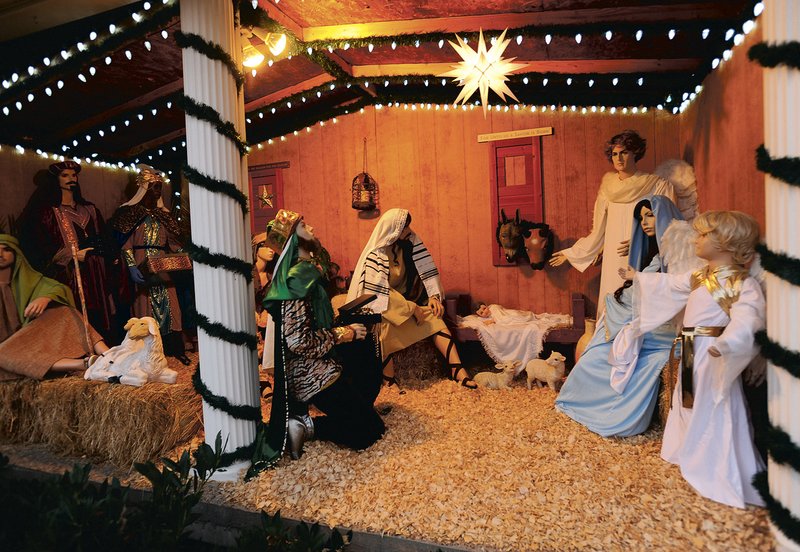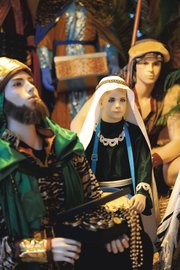By now, most Christian families have not only torn the paper off their Christmas gifts, but also taken advantage of the low prices of those same items at the after-Christmas sales. But alongside the frenzied Christmas customs, many struggle to reconcile the cultural excess of Christmas, leaving the gift of the child in the manger as a simple back story.
12 days of secrets
The “12 days of Christmas” are literally the 12 days between Christmas Day, Dec. 25, the birth of Jesus, and the Epiphany, Jan. 6, the day Christians celebrate the arrival of the Magi (Wise Men) and the “revelation of Christ as the light of the world.”
The Christmas song, “12 Days of Christmas,” might sound silly and artificial to many, but it actually had its origins in religious symbolism — and with a serious purpose.
It dates from a time of religious persecution. The song was written as a kind of secret catechism that one could sing in public without fear of arrest — a learning or memory aid to Christians in fact. The song can be taken at two levels of interpretation — the surface meaning, or the hidden meaning known only to Christians who are involved.
Each element below is a code word for a religious truth.
One partridge in a pear tree — Jesus Christ.
Two turtle doves — Old Testament.
Three French hens — Faith, hope and love.
Four calling birds — The four gospels: Matthew, Mark, Luke and John.
Five golden rings — The Torah or Law; the first five books of the Old Testament.
Six geese a’ laying — The six days of creation.
Seven swans a’ swimming — The seven-fold gifts of the Holy Spirit: prophesy, service, teaching, exortation, contribution, leadership and mercy.
Eight maids a milking — The eight beatitudes.
From here below, the order is different than the original song.
Nine ladies dancing — Nine fruits of the Holy Spirit: love, peace, joy, patience, kindness, goodness, faithfulness, gentleness and self-control.
10 Lords a’ leaping — The Ten Commandments.
11 Pipers piping — The 11 faithful disciples.
12 Drummers drumming — The 12 points in the Apostle’s Creed.
Source: The Rev. Salvador Marquez-Munoz, St. Mary’s Catholic Church, Siloam Springs
By now, most Christian families have not only torn the paper off their Christmas gifts, but also taken advantage of the low prices of those same items at the after-Christmas sales. But alongside the frenzied Christmas customs, many struggle to reconcile the cultural excess of Christmas, leaving the gift of the child in the manger as a simple back story.
"I want to remind people that Jesus is the main reason for the season," said the Rev. Salvador Marquez-Munoz, pastor of St. Mary's Catholic Church in Siloam Springs. "Christ is in Christmas. He brought Salvation for our world. The greatest gift of all was God's son to us."
Common thought has many of our modern Christmas traditions descending from the "pagans." But with newer research -- although often inconclusive -- historians have tied many of those cultural icons to Christian roots, with the trees and tinsel serving as a reminder of the "Reason."
"Take Santa Claus, he was a real Catholic saint, St. Nicholas," said the priest. "He was ordained as a bishop in the church in Myra."
Although his parents were very devout, St. Nicholas was orphaned at a young age. Nicholas was named Archbishop of Myra (still a dioceses in Greece) during the third century, and, in those days, bishops wore red robes and hats. Nicholas was persecuted for his faith.
But Nicholas' troubles actually drew him closer to God and seem to have made him sympathetic to the suffering of others, reads celebratingtheholidays.com. Nicholas used the large inheritance left by his parents to honor God. Numerous stories of Nicholas' generosity and even miracles remain. After his death on Dec. 6, a tradition of gift giving -- by putting money in stockings -- was begun in his honor.
"Although the modern Santa Claus has devolved into a secularized figure surrounded by fantasy, his image can serve to help us remember the real St. Nicholas, a man who devoted his life to serving God and inspiring others to do the same," read the celebratingholidays website, written by Angie Mosteller, a self-described evangelical blogger, a tutor for the Classical Conversations home school program and contributing writer for crosswalk.com and Rose Publishing.
"Furthermore, the idea of giving gifts in Santa's name is a useful practice. In essence, when gifts are given in Santa's name, they are given anonymously. Secret generosity is consistent with how St. Nicholas gave gifts, and more importantly, it follows Jesus' instruction to let our giving be done in secret. As Jesus said, 'Your Father who sees what is done in secret will reward you.'" (Matthew 6:4)
TWELVE DAYS
Many of today's traditions have evolved through tough times for Christians, such as the years 1528 to 1889, when Catholics in England were not allowed to practice their faith.
"Henry VIII was head of the Church of England," Marquez-Munoz related. "He was a devout Catholic, but found it difficult to accept all the rules, and wanted to segregate England from the Church in Rome.
"Anyone who went against the king (and some successors) were considered traitors, and they paid for it with their life."
Catholics, however, wanted to keep their faith alive and related Catholic catechisms in other ways. One example is the popular English carol, "The 12 Days of Christmas."
"Someone during that era wrote this carol as a catechism song for young Catholics," reads the website of the Catholic News Agency. "It has two levels of meaning: the surface meaning, plus a hidden meaning known only to members of the Church. Each element in the carol has a code word for a religious reality which the children could remember."
For example, "A partridge in a pear tree" was Jesus Christ, Marquez-Munoz explained. "'Two turtle doves' were the Old and New Testaments. 'Six geese a laying' stood for the six days of creation."
However, gifts after No. 9 were not included in the original catechism, he continued. "They kept adding more, but they are not holy, you know."
"The 'True Love' one hears in the song is not a smitten boy or girlfriend but Jesus Christ, because truly Love was born on Christmas Day," reads the Catholic website. "The partridge in the pear tree also represents him because that bird is willing to sacrifice its life if necessary to protect its young by feigning injury to draw away predators."
The 12 days refer roundabout to Epiphany: Jan. 6, 12 days after Christmas and the day the three wise men reached the stable after following the star -- also, the day the manifestation of God as man was revealed to the world, Marquez-Munoz. In some cultures, gifts are shared on these 12 days rather than at Christmas.
Throughout the 16th and 17th centuries, songs and poems continued as teaching tools because the people did not know how to read, Marquez-Munoz said. "This is how they passed their faith from their ancestors to the younger generation."
The stained-glass windows in old Catholic churches also told traditions of the faith, depicting different scenes in the life of Jesus and the saints.
O CHRISTMAS TREE
The origin of the Christmas tree is up for debate, though.
"Long before the advent of Christianity, plants and trees that remained green all year had a special meaning for people in the winter," reads the website history.com, sponsored by the History Channel. "Just as people today decorate their homes during the festive season with pine, spruce, and fir trees, ancient peoples hung evergreen boughs over their doors and windows. In many countries, it was believed that evergreens would keep away witches, ghosts, evil spirits and illness."
The celebration centered around the winter solstice (which was Tuesday), the shortest day of the year and also the first day of winter. Many ancient people (called "pagans") believed the sun was a god and that winter came every year because the sun god had become sick and weak.
"They celebrated the solstice because it meant, that at last, the sun god would begin to get well," the website reads. "Evergreen boughs reminded them of all the green plants that would grow again when the sun god was strong and summer would return."
The tradition of bringing trees into houses is credited to the Germans, and Martin Luther, the 16th-century Protestant reformer and a German, first added lighted candles to a tree.
"Walking toward his home one winter evening, composing a sermon, he was awed by the brilliance of stars twinkling amid evergreens," continues history.com. "To recapture the scene for his family, he erected a tree in the main room and wired its branches with lighted candles."
"Lighted trees were certainly used in various pagan religious celebrations throughout history, but contrary to popular belief, there does not appear to be any direct link between the pagan rituals and the Christmas tree," reads celebratingholidays.com. "Rather, the Christmas tree almost certainly has its roots (no pun intended) in Christian practices."
Mosteller referred to St. Boniface in the 18th century. He served as a missionary for some of the remotest tribes in Germany and chopped down the oak tree believed to be the home of the Norse god Thor.
"Tradition holds that a fir tree was growing in the roots of the oak, and Boniface claimed the tree as a symbol of Christ," the site continues. "Needless to say, the people readily accepted Boniface's message, and the tree would serve as a reminder of the mighty God who was humbly born into the world as a man on Christmas day.
"Interestingly, in the Bible, God compares himself to a tree," Mosteller concluded. "He says, 'I am like a green pine tree; your fruitfulness comes from me" (Hosea 14:8b). This is a relevant analogy to consider during the Christmas season. The fruitful lives of Christians can serve as the 'ornaments' that draw others to admire the 'tree -- God himself!"
NAN Religion on 12/26/2015



